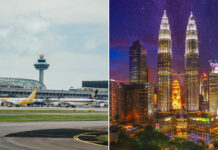SINGAPORE: The new passenger terminal at Seletar Airport which costs S$80 million will be operational by the end of 2018, said Changi Airport Group (CAG).
The two-storey, 10,000 sq m terminal can handle 700,000 passenger movements a year – about 26 times more than the number of passengers it saw in 2016, according to CAG.
The departure area will house four check-in counters, six immigration lanes, two security screening stations and a gate holdroom that can accommodate 200 passengers.
Artist’s impression of Seletar Airport check-in counters. (Image: Changi Airport Group)
“This new terminal will provide Seletar Airport with the capacity it needs to handle the upcoming growth in aviation activities in the years ahead,” said Mr Khoh Su Lim, Deputy General Manager of the airport.
“It’s going to provide our passengers with a more efficient process flow for both scheduled as well as non-scheduled passengers.”
Managed by CAG, the terminal will also have three aircraft parking stands next to it.
That will increase the efficiency and convenience of boarding the planes, the management team said.
A private area, known as the Seletar Business Aviation Centre, will also be set up for those travelling on chartered business flights and private jets.
But the terminal will not have any retail outlets, except for one food & beverage stall.
Malaysian carrier Firefly will shift its operations from Changi Airport to Seletar when the terminal opens.
It will continue running its 20 daily turboprop flights – to and from Subang, Ipoh and Kuantan.
Changi Airport Group said relocating these “smaller and slower aircraft operations” to Seletar would help “optimise the use of resources to meet growing capacity demands” at Changi.
Observers say that this move would benefit certain segments of the market.
“Some consumers who fly between Singapore and Kuala Lumpur will benefit as they might appreciate the convenience of a very small airport that’s easy to go through,” said Mr Brendan Sobie, Chief Analyst at CAPA Centre for Aviation.
Another plus for consumers is that fares could go down if more players enter the market.
“We expect competition on the route, which hasn’t been possible until the opening of this airport. Malindo Air may now be able to compete with Firefly on the market – which should drive down the fares, which are relatively high between Changi and Subang. What that will do is potentially stimulate initial demand,” added Mr Sobie.
However, he also said that the new terminal may not move the needle on Singapore’s passenger arrivals. Its capacity is about 1 per cent the size of Changi Airport’s 62 million passenger arrivals last year.
The upgrade marks the latest step in the redevelopment of Seletar Airport which started in 2008.
Since then, the airport has undergone several enhancements, such as the lengthening of its runway and the construction of a new control tower and fire station.




